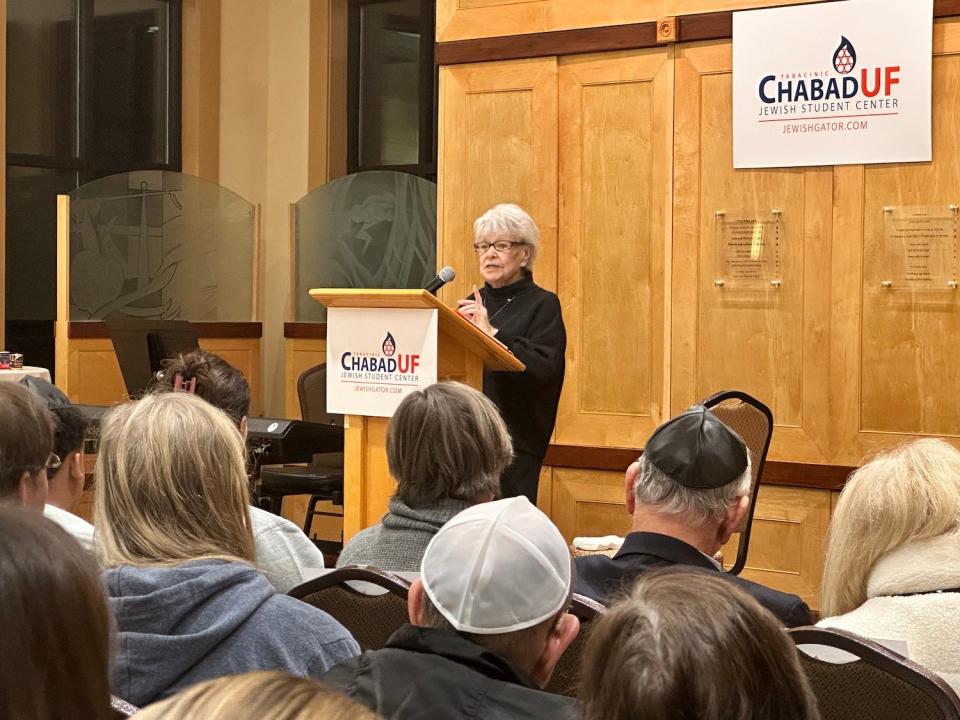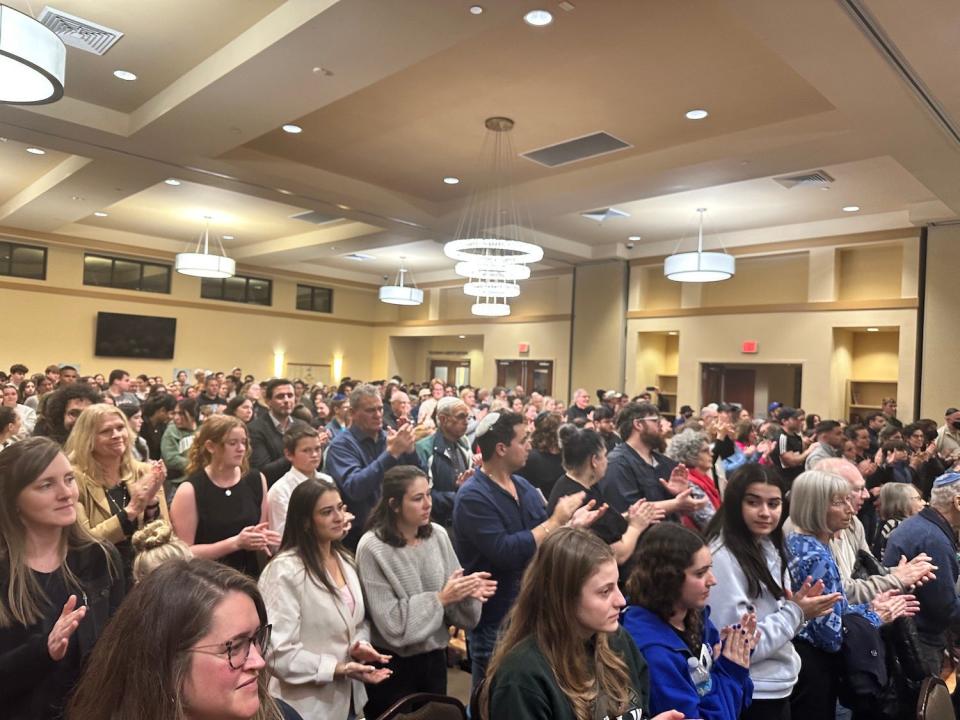Holocaust survivor promotes tolerance as she shares harrowing experiences with Gainesville crowd
A standing-room only crowd at the Chabad UF Jewish Student Center listened intently on Monday as Holocaust survivor Irene Zisblatt told of how she came face to face with death at the notorious Auschwitz-Birkenau death camp.
One of 1,500 in her barracks selected for the gas chamber, Zisblatt, 13, fought for her life when she realized everyone would not fit inside the underground room. Using all her strength and digging her fingernails into the chamber door, she avoided getting pushed back inside.
As the gas began to flow, an SS soldier was ordered to shut the door. Unable due to Zisblatt’s presence, he threw the young girl to the side, slammed the door and ran to safety to avoid the gas.
Zisblatt ran back up the ramp from the gas chamber and found a small place to hide.
“For that moment, I had hope,” she said with vigor.

She was discovered shortly after by a Sonderkommando, a prisoner forced to perform various duties, including bringing the dead bodies from the gas chambers to the crematoriums.
The man — Zisblatt estimated he was about 18 — took his jacket and covered her naked body. He quietly took her around the corner to a train destined for a labor camp. Zisblatt recalled him telling her he had just three days left to live, and that “If you make it, live a little for me, too.”
More: Bestselling author Ibram X. Kendi talks adaptation of 'Barracoon' in return to Gainesville
“I live for him every day, a little bit,” Zisblatt said.
An estimated 6 million European Jews and people from other minorities were killed by the Nazis between 1941 and 1945. Zisblatt, now 95, is one of an estimated 245,000 remaining survivors, according to a recently released study by the New York-based Conference on Jewish Material Claims Against Germany.
Her testimony was featured in director Steven Spielberg’s Oscar-winning 1998 documentary "The Last Days." Her autobiography, "The Fifth Diamond," is described as a "testament to the triumph of the human spirit."
Monday night's program began with prayers and the lighting of candles in honor of those killed during the Holocaust. Local musicians Stephen Fine, Alan Clark and Sophie De performed the theme from "Schindler's List," Spielberg’s award-winning drama set in German-occupied Poland.
Zisblatt, born Dec. 28, 1929, lived in the Carpathian Mountains region of her native Hungary with her five siblings — four brothers and a sister — and her parents.
She said in 1939, when Germany invaded Poland, those who escaped on their way to Palestine tried to tell others of the atrocities they had witnessed, but her father, like most others, ignored the warnings.
"No one believed that the most civilized country (Germany) in all of Europe was acting like barbarian people and killing children," Zisblatt said.
The consequences of her father's decision to stay soon became evident, however, as families across Hungary were placed into ghettos and then crammed into cattle cars and shipped to camps in Poland.
Zisblatt's only remaining valuables were a few diamonds — which she wears around her neck today— that her mother had sown into her skirt for safe keeping and to buy bread. She later shared that she was forced to eat the diamonds numerous times in an effort to keep them hidden.
Zisblatt estimated they were in the boxcar for three days and four nights. When they arrived at Auschwitz, families were quickly separated.
"We never saw our fathers, our brothers or our belongings again, she said.
She was then forcibly separated from her mother.
"I heard my mom yell out, 'Don't cry, I will come for you later,' " Zisblatt said. "That was the last time I heard my mother's voice."
With her head shaved and her clothes taken, Zisblatt, unsure as to where her mother was taken, said she later tried to find her herself. She was stopped, however, by a guard at the barrack's doors.
"She pushed my head out of the door and pointed to the chimneys — the smoke coming out of the chimneys — and she said, 'Just about now your mother is coming out one of those chimneys.' "
That was one of several moments that caused Zisblatt to choke up, the pain still clearly visible 80 years later.
Zisblatt said the next day she was made to take part in "brutal" experiments conducted by the infamous Joseph Mengle, who is often referred to as the "Angel of Death."
"I saw the joy in his eyes," she said of Mengle.
After later avoiding the the gas chamber, Zisblatt was on her way to Germany, where she was put to work in an ammunition factory. She worked in the factory with her friend Sabka, whom she met at Auschwitz, until January 1945, when prisoners were moved away via death marches to avoid Allied forces.
"We marched every day," Zisblatt said. "We ate the snow we walked on to survive."
Zisblatt and Sabka later escaped in April under the cover of darkness.
"We started running in the woods, not knowing where we were or where we were going," Zisblatt said.

They were found the next day by American soldiers, asleep at an abandoned farm. The two girls were taken to a nearby field hospital.
Sabka died of typhus fever that night in her sleep.
Moved to a camp in Austria, Zisblatt, at that point 14, received a letter while awaiting transfer to an orphanage from a man in the U.S. with the same last name as her. Asked if she wanted to come to America, Zisblatt agreed. She remained at the camp for another three years before her transfer was processed.
She found out later that the letter came from her father's brother, who had moved to the U.S. as a teenager after World War I.
After arriving in New York in 1947, she discovered that her father had two more brothers and two sisters living nearby.
"I couldn't believe it. Now I have aunts and uncles and cousins," she said.
Zisblatt didn't speak for 50 years about her days at Auschwitz, the human experiments, the labor camp or the death march. She said she returned to the concentration camp in 1994 with 5,000 students, and learned the importance of passing on her history and knowledge to future generations.
"We cannot allow the flames of hatred to consume our world," she said. "I came forward to share my degrading story to hopefully influence you and generations to come to work for tolerance and understanding."
This article originally appeared on The Gainesville Sun: Holocaust survivor Irene Zisblatt speaks in Gainesville Florida

